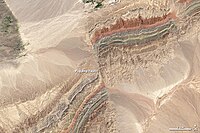
Photo from wikipedia
The geologic slip rate on the Mojave section of the San Andreas fault is poorly constrained, despite its importance for understanding earthquake hazard, apparent discrepancies between geologic and geodetic slip… Click to show full abstract
The geologic slip rate on the Mojave section of the San Andreas fault is poorly constrained, despite its importance for understanding earthquake hazard, apparent discrepancies between geologic and geodetic slip rates along this fault section, and long-term fault interactions in southern California. Here, we use surficial geologic mapping, excavations, and radiocarbon and luminescence dating to quantify the displacements and ages of late Holocene landforms offset by the fault at three sites. At the Ranch Center site, the slip rate is determined using the base of a fan marking incision and deflection of an ephemeral channel. At the adjacent Key Slide site, the margin of a landslide deposited on indigenous fire hearths provides a minimum rate. At the X-12 site, the slip rate is determined from a channel that incised into a broad fan surface, and is deflected and beheaded by the fault. We use maximum–minimum bounds on both the displacement and age of each offset feature to calculate slip rate for each site independently. Overlap of the three independent rate ranges yields a rate of 33–39 mm/yr over the last 3 ka, under the assumption that the sites share a common history, given their proximity. Considered in sequence, site-level epistemic uncertainties in the data permit but do not require a rate increase since ∼1200 cal B.P. Modest rate changes can be explained by aleatory variability in earthquake timing and magnitude; larger changes could suggest a shared regional variation with the Garlock and other faults. The new late Holocene slip rates are consistent with geodetic model estimates that include a viscoelastic crust and earthquake cycle effects. The geologic slip rates also provide average slip over dozens of earthquake cycles—a key constraint for long-term earthquake rupture forecasts.
Journal Title: Bulletin of the Seismological Society of America
Year Published: 2021
Link to full text (if available)
Share on Social Media: Sign Up to like & get
recommendations!